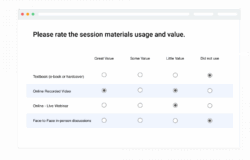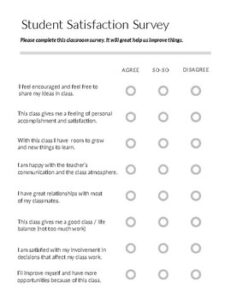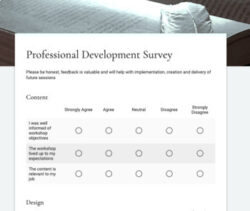Understanding the true impact and effectiveness of professional development programs for teachers is paramount for any educational institution aiming for continuous improvement. It is not enough to simply offer workshops and courses; truly beneficial professional development actively engages educators, addresses their specific needs, and ultimately, enhances their teaching practice and student outcomes. This is where a well-crafted survey becomes an indispensable tool, allowing you to gather direct feedback and ensure your efforts are truly hitting the mark.
Without a structured way to collect insights, professional development initiatives can sometimes miss the mark, leaving teachers feeling unheard or unfulfilled. A thoughtfully designed teacher professional development survey template provides a systematic approach to gather crucial information, identify areas of strength, pinpoint weaknesses, and most importantly, guide future planning to create more relevant and impactful learning experiences for your dedicated educators. It transforms anecdotal evidence into actionable data, paving the way for targeted and effective growth.
Why a Robust Survey Template is Essential for Effective PD
In today’s dynamic educational landscape, professional development isn’t just a compliance checkbox; it’s a strategic investment in human capital. To ensure this investment yields maximum returns, relying on intuition alone won’t suffice. A comprehensive survey template acts as your data compass, guiding you toward informed decisions by capturing the diverse perspectives of your teaching staff. It moves you beyond assumptions, providing tangible evidence of what’s working, what needs refining, and what new areas of support teachers truly desire.
Implementing a standardized survey allows for consistency in data collection across different professional development events or over time. This consistency is vital for tracking trends and measuring the long-term impact of your programs. You can identify patterns, compare feedback from various sessions, and ultimately refine your offerings to be more aligned with the evolving needs of your teachers. This iterative process of feedback and refinement is the hallmark of a truly effective professional development strategy.
Moreover, a well-structured survey empowers teachers by giving them a voice. When educators feel their opinions are valued and directly contribute to shaping their learning opportunities, engagement naturally increases. This sense of ownership and involvement can significantly boost morale and encourage active participation in future professional development initiatives. It fosters a culture of continuous learning and improvement where teachers are partners in their own growth, not just recipients of information.
Beyond just feedback on specific sessions, a detailed teacher professional development survey template can uncover broader professional learning needs within your school or district. It can help you identify systemic gaps in knowledge or skills, allowing you to proactively design future programs that address these underlying issues. This forward-looking approach ensures that your professional development efforts are not just reactive but strategically aligned with long-term educational goals and challenges.
Key Elements of a Comprehensive Teacher PD Survey
- Clarity on Learning Objectives: Did teachers understand what they were supposed to gain?
- Relevance to Practice: Was the content directly applicable to their daily classroom work?
- Quality of Facilitation: How effective were the presenters or trainers in delivering the material?
- Engagement and Participation: Did the professional development encourage active involvement?
- Impact on Teaching: How has the professional development changed their instructional methods or beliefs?
- Future Needs: What specific topics or formats would teachers like to see in upcoming sessions?
Leveraging Your Teacher Professional Development Survey Template for Impact
Once you’ve collected the valuable insights from your professional development surveys, the real work begins: analyzing the data and transforming it into actionable strategies. Simply gathering responses isn’t enough; the power lies in how you interpret and apply that information. Look for common themes, identify outliers, and categorize feedback to pinpoint areas of consistent praise or concern. This detailed analysis forms the foundation for meaningful program improvements.
Communicate your findings transparently with your teaching staff and other stakeholders. Share what you learned from the survey results, highlighting both successes and areas for improvement. This open dialogue reinforces the message that their feedback is valued and demonstrates accountability. When teachers see that their input directly leads to changes and better future professional development opportunities, it builds trust and encourages continued participation in the feedback loop.
Based on the insights gleaned from your survey, prioritize changes and develop an implementation plan. This might involve adjusting the content of future workshops, exploring different delivery methods, or even re-evaluating the overall professional development calendar. For instance, if many teachers expressed a need for more practical application opportunities, future sessions could incorporate more hands-on activities or collaborative planning time.
Remember that professional development is an ongoing journey, not a one-time event. Regularly utilizing a robust teacher professional development survey template allows you to establish a continuous cycle of feedback, analysis, implementation, and re-evaluation. Each round of surveys builds upon the last, providing increasingly nuanced insights and fostering an environment where professional learning is continuously refined and optimized to meet the evolving needs of your educators, ultimately supporting their growth and student success.
Investing in a systematic approach to collecting feedback on professional development is a strategic move that pays dividends. It ensures that every hour dedicated to teacher growth is maximized for impact, leading to more skilled, confident, and effective educators in the classroom. This commitment to responsive and tailored professional learning is a cornerstone of a thriving educational community.



